Impact of the Seven Years' War and Colonial Dynamics in America
VerifiedAdded on 2023/04/12
|5
|853
|386
Essay
AI Summary
This essay examines the Seven Years' War (also known as the French and Indian War) between England and France over the ownership of colonial settlements in North America, highlighting its role in sowing the seeds of the American Revolution. It discusses how figures like George Washington gained influence during this period and how the war transformed loyal British subjects in the thirteen colonies into adversaries seeking independence. The essay also incorporates insights from Sarah Shade's memoir, providing a perspective on British-Indian relations and colonial life, contrasting her account with that of Hannah Snell. Ultimately, the essay connects these historical narratives to illustrate the shift in colonial sentiment following the Seven Years' War and the growing desire for self-determination.
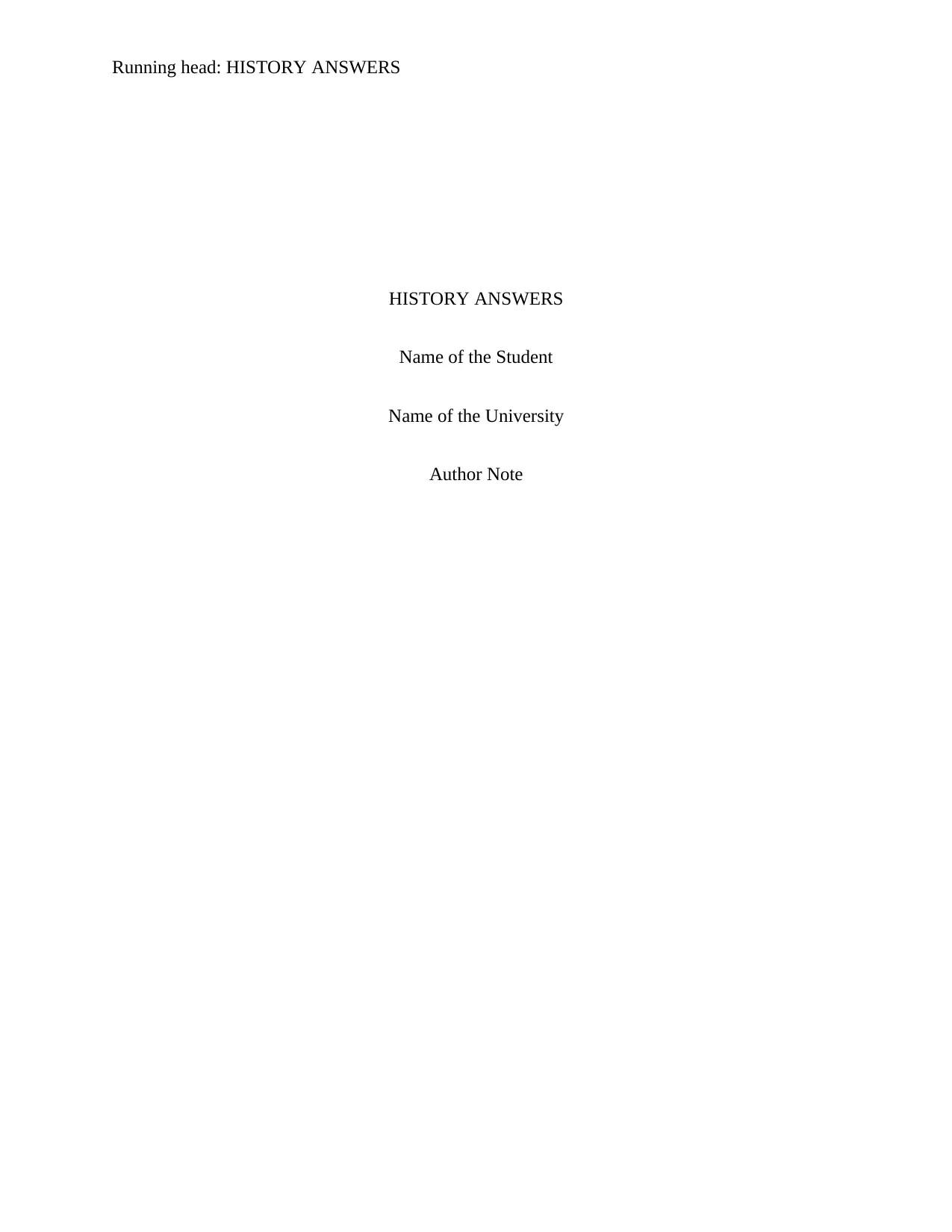
Running head: HISTORY ANSWERS
HISTORY ANSWERS
Name of the Student
Name of the University
Author Note
HISTORY ANSWERS
Name of the Student
Name of the University
Author Note
Paraphrase This Document
Need a fresh take? Get an instant paraphrase of this document with our AI Paraphraser
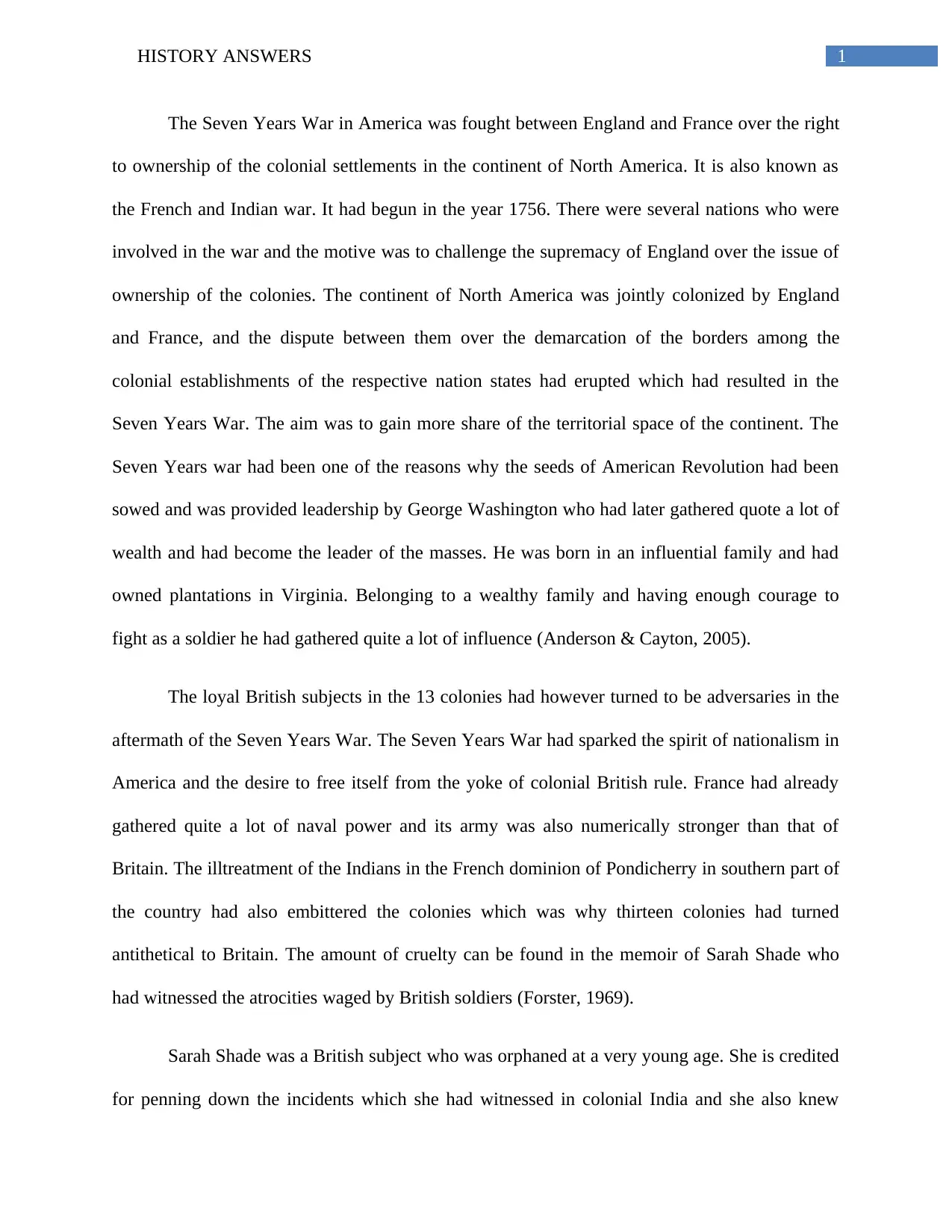
1HISTORY ANSWERS
The Seven Years War in America was fought between England and France over the right
to ownership of the colonial settlements in the continent of North America. It is also known as
the French and Indian war. It had begun in the year 1756. There were several nations who were
involved in the war and the motive was to challenge the supremacy of England over the issue of
ownership of the colonies. The continent of North America was jointly colonized by England
and France, and the dispute between them over the demarcation of the borders among the
colonial establishments of the respective nation states had erupted which had resulted in the
Seven Years War. The aim was to gain more share of the territorial space of the continent. The
Seven Years war had been one of the reasons why the seeds of American Revolution had been
sowed and was provided leadership by George Washington who had later gathered quote a lot of
wealth and had become the leader of the masses. He was born in an influential family and had
owned plantations in Virginia. Belonging to a wealthy family and having enough courage to
fight as a soldier he had gathered quite a lot of influence (Anderson & Cayton, 2005).
The loyal British subjects in the 13 colonies had however turned to be adversaries in the
aftermath of the Seven Years War. The Seven Years War had sparked the spirit of nationalism in
America and the desire to free itself from the yoke of colonial British rule. France had already
gathered quite a lot of naval power and its army was also numerically stronger than that of
Britain. The illtreatment of the Indians in the French dominion of Pondicherry in southern part of
the country had also embittered the colonies which was why thirteen colonies had turned
antithetical to Britain. The amount of cruelty can be found in the memoir of Sarah Shade who
had witnessed the atrocities waged by British soldiers (Forster, 1969).
Sarah Shade was a British subject who was orphaned at a very young age. She is credited
for penning down the incidents which she had witnessed in colonial India and she also knew
The Seven Years War in America was fought between England and France over the right
to ownership of the colonial settlements in the continent of North America. It is also known as
the French and Indian war. It had begun in the year 1756. There were several nations who were
involved in the war and the motive was to challenge the supremacy of England over the issue of
ownership of the colonies. The continent of North America was jointly colonized by England
and France, and the dispute between them over the demarcation of the borders among the
colonial establishments of the respective nation states had erupted which had resulted in the
Seven Years War. The aim was to gain more share of the territorial space of the continent. The
Seven Years war had been one of the reasons why the seeds of American Revolution had been
sowed and was provided leadership by George Washington who had later gathered quote a lot of
wealth and had become the leader of the masses. He was born in an influential family and had
owned plantations in Virginia. Belonging to a wealthy family and having enough courage to
fight as a soldier he had gathered quite a lot of influence (Anderson & Cayton, 2005).
The loyal British subjects in the 13 colonies had however turned to be adversaries in the
aftermath of the Seven Years War. The Seven Years War had sparked the spirit of nationalism in
America and the desire to free itself from the yoke of colonial British rule. France had already
gathered quite a lot of naval power and its army was also numerically stronger than that of
Britain. The illtreatment of the Indians in the French dominion of Pondicherry in southern part of
the country had also embittered the colonies which was why thirteen colonies had turned
antithetical to Britain. The amount of cruelty can be found in the memoir of Sarah Shade who
had witnessed the atrocities waged by British soldiers (Forster, 1969).
Sarah Shade was a British subject who was orphaned at a very young age. She is credited
for penning down the incidents which she had witnessed in colonial India and she also knew
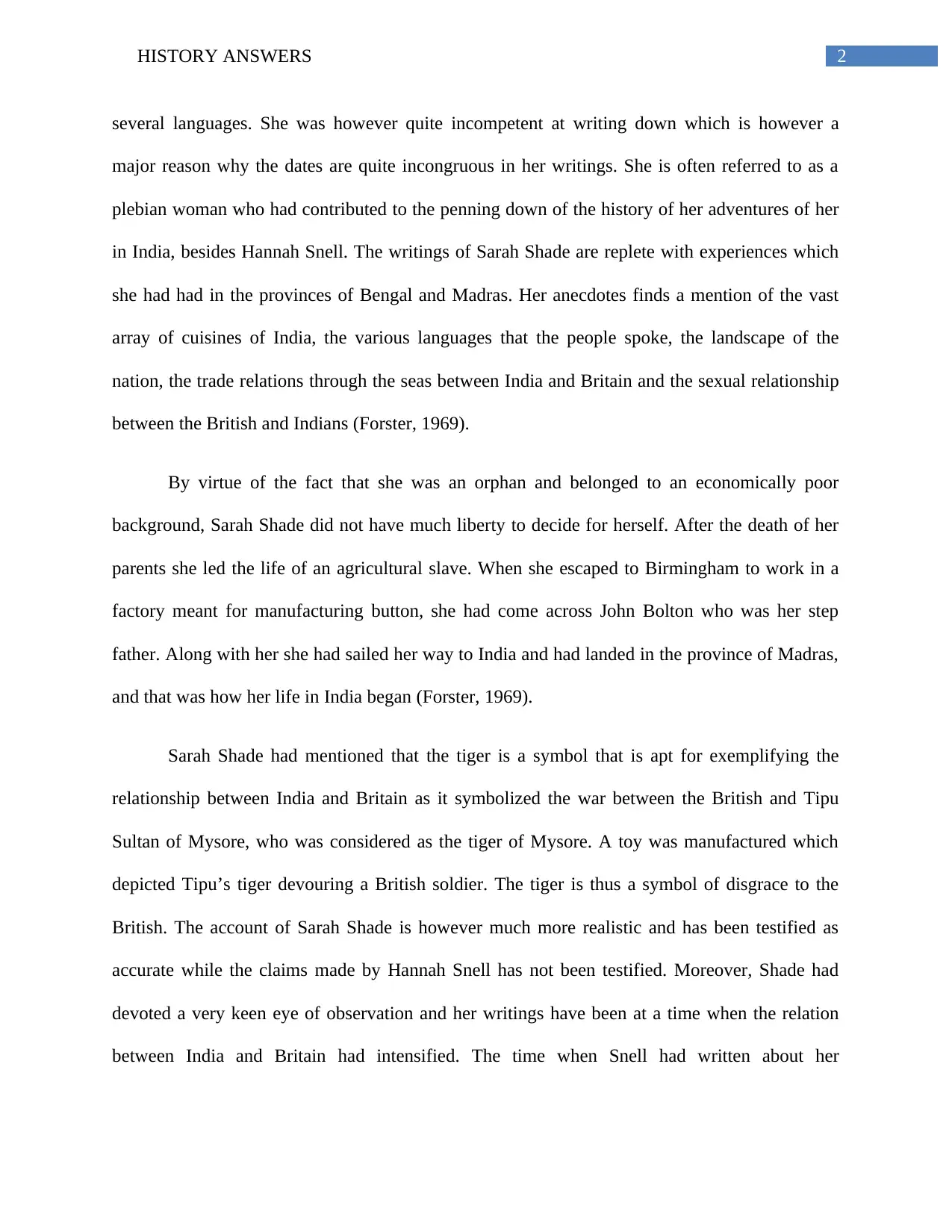
2HISTORY ANSWERS
several languages. She was however quite incompetent at writing down which is however a
major reason why the dates are quite incongruous in her writings. She is often referred to as a
plebian woman who had contributed to the penning down of the history of her adventures of her
in India, besides Hannah Snell. The writings of Sarah Shade are replete with experiences which
she had had in the provinces of Bengal and Madras. Her anecdotes finds a mention of the vast
array of cuisines of India, the various languages that the people spoke, the landscape of the
nation, the trade relations through the seas between India and Britain and the sexual relationship
between the British and Indians (Forster, 1969).
By virtue of the fact that she was an orphan and belonged to an economically poor
background, Sarah Shade did not have much liberty to decide for herself. After the death of her
parents she led the life of an agricultural slave. When she escaped to Birmingham to work in a
factory meant for manufacturing button, she had come across John Bolton who was her step
father. Along with her she had sailed her way to India and had landed in the province of Madras,
and that was how her life in India began (Forster, 1969).
Sarah Shade had mentioned that the tiger is a symbol that is apt for exemplifying the
relationship between India and Britain as it symbolized the war between the British and Tipu
Sultan of Mysore, who was considered as the tiger of Mysore. A toy was manufactured which
depicted Tipu’s tiger devouring a British soldier. The tiger is thus a symbol of disgrace to the
British. The account of Sarah Shade is however much more realistic and has been testified as
accurate while the claims made by Hannah Snell has not been testified. Moreover, Shade had
devoted a very keen eye of observation and her writings have been at a time when the relation
between India and Britain had intensified. The time when Snell had written about her
several languages. She was however quite incompetent at writing down which is however a
major reason why the dates are quite incongruous in her writings. She is often referred to as a
plebian woman who had contributed to the penning down of the history of her adventures of her
in India, besides Hannah Snell. The writings of Sarah Shade are replete with experiences which
she had had in the provinces of Bengal and Madras. Her anecdotes finds a mention of the vast
array of cuisines of India, the various languages that the people spoke, the landscape of the
nation, the trade relations through the seas between India and Britain and the sexual relationship
between the British and Indians (Forster, 1969).
By virtue of the fact that she was an orphan and belonged to an economically poor
background, Sarah Shade did not have much liberty to decide for herself. After the death of her
parents she led the life of an agricultural slave. When she escaped to Birmingham to work in a
factory meant for manufacturing button, she had come across John Bolton who was her step
father. Along with her she had sailed her way to India and had landed in the province of Madras,
and that was how her life in India began (Forster, 1969).
Sarah Shade had mentioned that the tiger is a symbol that is apt for exemplifying the
relationship between India and Britain as it symbolized the war between the British and Tipu
Sultan of Mysore, who was considered as the tiger of Mysore. A toy was manufactured which
depicted Tipu’s tiger devouring a British soldier. The tiger is thus a symbol of disgrace to the
British. The account of Sarah Shade is however much more realistic and has been testified as
accurate while the claims made by Hannah Snell has not been testified. Moreover, Shade had
devoted a very keen eye of observation and her writings have been at a time when the relation
between India and Britain had intensified. The time when Snell had written about her
⊘ This is a preview!⊘
Do you want full access?
Subscribe today to unlock all pages.

Trusted by 1+ million students worldwide
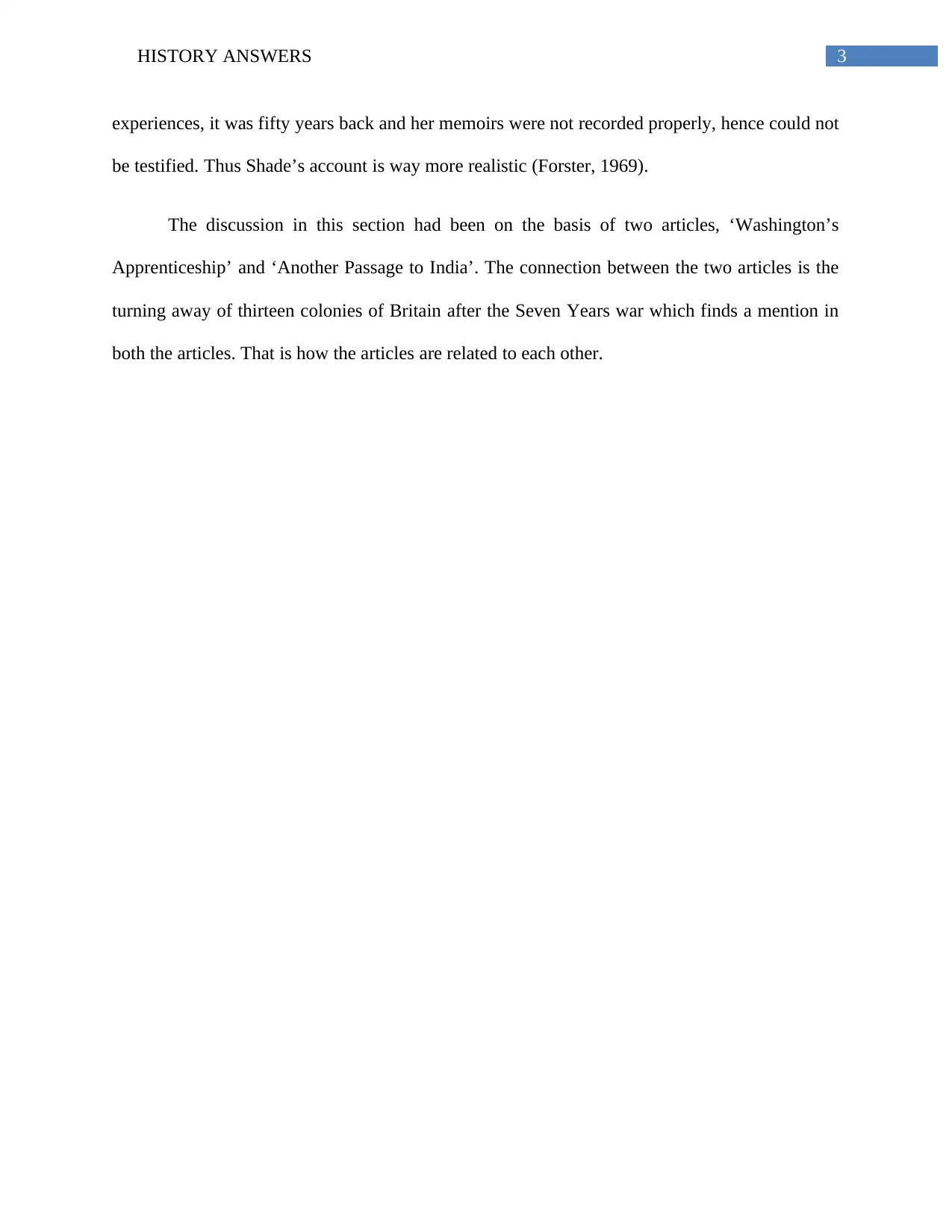
3HISTORY ANSWERS
experiences, it was fifty years back and her memoirs were not recorded properly, hence could not
be testified. Thus Shade’s account is way more realistic (Forster, 1969).
The discussion in this section had been on the basis of two articles, ‘Washington’s
Apprenticeship’ and ‘Another Passage to India’. The connection between the two articles is the
turning away of thirteen colonies of Britain after the Seven Years war which finds a mention in
both the articles. That is how the articles are related to each other.
experiences, it was fifty years back and her memoirs were not recorded properly, hence could not
be testified. Thus Shade’s account is way more realistic (Forster, 1969).
The discussion in this section had been on the basis of two articles, ‘Washington’s
Apprenticeship’ and ‘Another Passage to India’. The connection between the two articles is the
turning away of thirteen colonies of Britain after the Seven Years war which finds a mention in
both the articles. That is how the articles are related to each other.
Paraphrase This Document
Need a fresh take? Get an instant paraphrase of this document with our AI Paraphraser
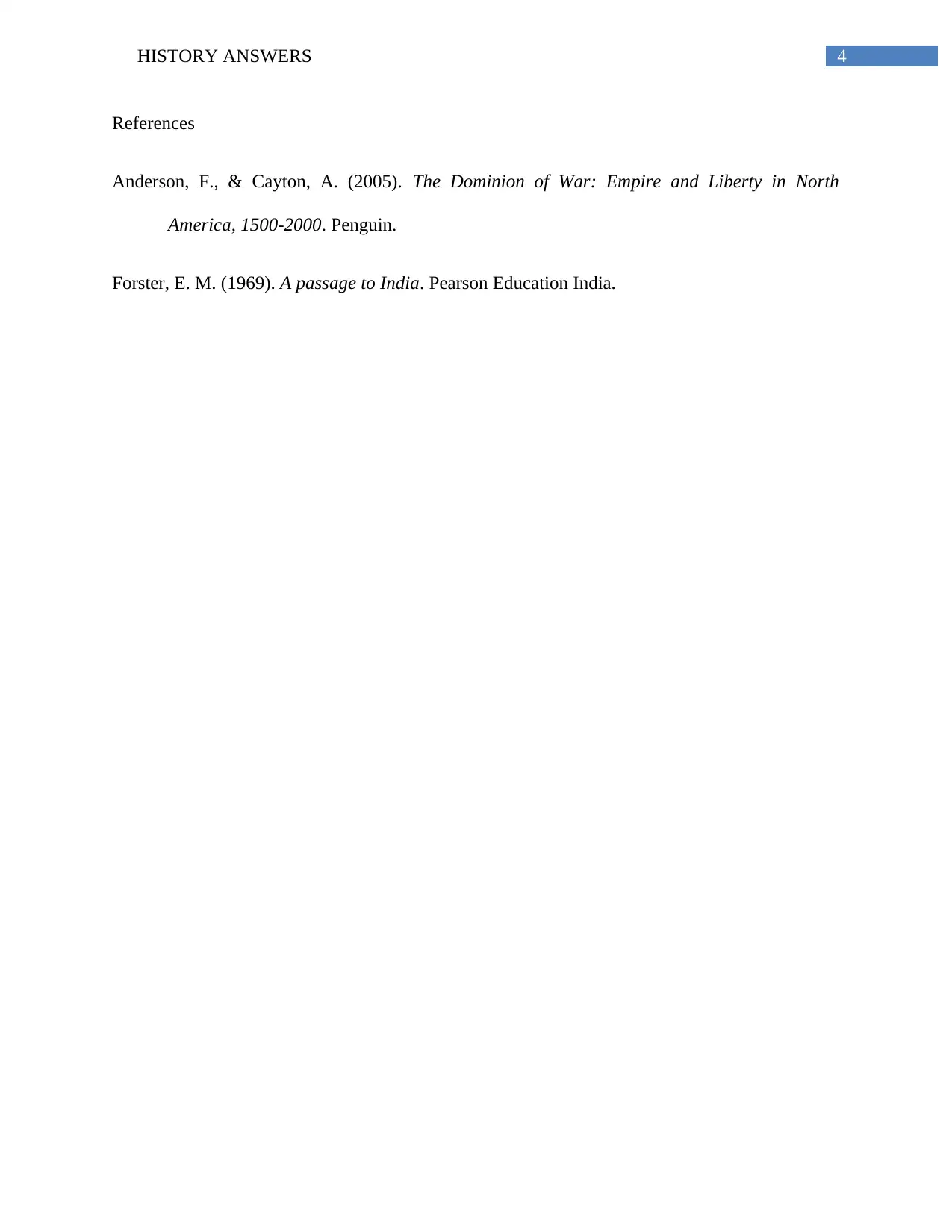
4HISTORY ANSWERS
References
Anderson, F., & Cayton, A. (2005). The Dominion of War: Empire and Liberty in North
America, 1500-2000. Penguin.
Forster, E. M. (1969). A passage to India. Pearson Education India.
References
Anderson, F., & Cayton, A. (2005). The Dominion of War: Empire and Liberty in North
America, 1500-2000. Penguin.
Forster, E. M. (1969). A passage to India. Pearson Education India.
1 out of 5
Related Documents
Your All-in-One AI-Powered Toolkit for Academic Success.
+13062052269
info@desklib.com
Available 24*7 on WhatsApp / Email
![[object Object]](/_next/static/media/star-bottom.7253800d.svg)
Unlock your academic potential
Copyright © 2020–2025 A2Z Services. All Rights Reserved. Developed and managed by ZUCOL.




